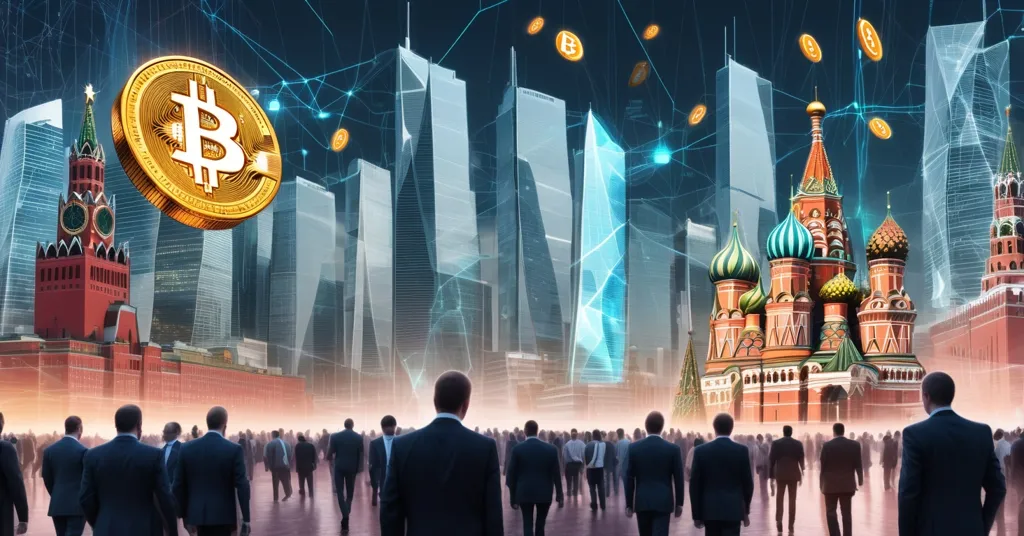Moscow Exchange Debuts Bitcoin & Ethereum Futures with $5M Trading Volume

Moscow Exchange Launches Bitcoin and Ethereum Futures with $5M Trading Debut
Russia’s largest stock market, the Moscow Exchange (MOEX), has kicked off a bold new chapter in crypto finance by launching Bitcoin (BTC) and Ethereum (ETH) index futures, clocking a staggering 418 million rubles—about $5.2 million USD—in trading volume on day one. With over 1,500 professional investors diving in, this move signals a tightly controlled yet undeniable embrace of cryptocurrency exposure within Russia’s financial system.
- First-Day Milestone: MOEX hits $5.2 million in trading volume for Bitcoin and Ethereum index futures.
- Investor Surge: Over 1,500 professional traders participate, heavily favoring Bitcoin.
- Regulatory Framework: Central Bank of Russia sanctions derivatives while sidestepping direct crypto ownership.
MOEX’s Crypto Debut: Breaking Down the Numbers
On the inaugural day of trading, MOEX rolled out cash-settled futures that let investors speculate on the price swings of Bitcoin and Ethereum without ever holding the actual digital coins. For the uninitiated, cash-settled futures are essentially financial bets—you predict whether the price will rise or fall, and at the contract’s end, you’re paid (or pay) the difference in rubles, not crypto. The Bitcoin index futures, labeled MOEXBTC, roared ahead with a volume of 356.79 million rubles, dwarfing Ethereum’s MOEXETH at 61.27 million rubles—a nearly six-to-one gap. This stark difference hints at Bitcoin’s ironclad status as the go-to crypto, even in derivative form, while Ethereum, despite its tech prowess with smart contracts, plays second fiddle in this market. For more details on the impressive trading figures, check out the latest report on Moscow Exchange’s $5 million crypto futures debut.
The participation stats tell a similar tale: 1,214 traders jumped on Bitcoin futures, compared to just 320 for Ethereum. Contracts were offered with expiration dates in December, January, and February, under tickers like BCZ5 for Bitcoin and ETZ5 for Ethereum. These indices aren’t plucked from thin air—they’re calculated daily using a weighted average of perpetual futures (contracts with no expiration) and swaps (agreements to exchange price differences over time) from major global exchanges like Binance, Bybit, OKX, and Bitget. This ties the pricing to real-world crypto market data, lending some legitimacy to the mechanism. But don’t think you can just log in with a spare hundred bucks—access is locked to “highly qualified” investors, a fancy way of saying only big-league traders with deep pockets and proven experience need apply.
Russia’s Regulatory Tightrope: Crypto on a Leash
The Central Bank of Russia has historically treated direct cryptocurrency trading like a loaded gun—intriguing, but too risky to hand out freely. Since 2020, retail crypto payments have been outright banned over fears of money laundering and capital flight, a stance reinforced by economic pressures from Western sanctions after the 2014 Crimea annexation and the 2022 Ukraine conflict. Yet, a shift is brewing. Since May, the bank has greenlit crypto derivatives for financial firms, and with MOEX’s latest launch, they’re even mulling instruments directly tied to crypto prices. It’s a cautious nod to innovation while keeping the wilder aspects of digital assets at bay.
This isn’t just about finance—it’s geopolitics. With sanctions strangling access to global markets and the U.S. dollar often wielded as a financial weapon against Russian interests, ruble-denominated crypto derivatives offer a workaround. They allow Russia to dip into the decentralized finance pool without diving headfirst or relying on foreign platforms that could dodge state oversight. As Maria Patrikeeva, Managing Director of the Derivatives Market at MOEX, put it:
“The launch of direct index futures on Bitcoin and Ethereum is a logical extension of the line of crypto derivatives available to traders in rubles and in a regulated Russian jurisdiction, without the need to purchase digital assets on foreign exchanges.”
In plain terms, Russia is saying, “We’ll play the crypto game, but by our rules, in our currency, on our turf.” MOEX isn’t new to this either—they’ve offered futures tied to U.S.-based spot Bitcoin ETFs (like iShares Bitcoin Trust) and Ethereum ETFs (iShares Ethereum Trust) since mid-year, pulling an average daily volume of 1.2 billion rubles ($15 million USD) last month. With the St. Petersburg Exchange also launching Bitcoin futures in October, it’s clear: Russia is crafting a domestic crypto derivatives market, one regulated brick at a time.
Bitcoin vs. Ethereum: Market Sentiment and Trading Behavior
Digging into who’s betting on what, there’s a telling divide among traders. According to Russian media outlet RBC:
“Notably, corporate traders predominantly held short positions (betting on a price decline), while individuals held more long positions (betting on a rise).”
Breaking that down, “shorting” means wagering the price will drop, often a cautious or bearish move, while “going long” is a bet on price growth, reflecting optimism or speculative hunger. Corporate players, likely hedging risk or tied to conservative strategies, seem skeptical—perhaps spooked by Bitcoin’s rollercoaster history or global economic headwinds. Individual pros, on the other hand, are rolling the dice on a moonshot, possibly banking on Bitcoin’s narrative as a digital gold or Ethereum’s promise of programmable money. Would you side with the cautious suits or the hopeful underdogs in Russia’s crypto ring?
That Bitcoin futures volume towers over Ethereum’s also speaks volumes. Bitcoin, as the original cryptocurrency, carries a gravitas and familiarity that Ethereum, with its complex smart contract ecosystem, struggles to match in conservative markets like this. It’s less about utility here and more about trust—BTC is the heavyweight champ, while ETH is still proving its contender status among Russian traders.
How These Futures Work—and Why They’re Risky
Let’s get under the hood of these cash-settled futures for a moment. When you trade MOEXBTC or MOEXETH, you’re not getting a wallet full of crypto at the end of the contract. Instead, when the contract expires (say, in December), the difference between your predicted price and the actual price—based on that weighted average from global exchanges—is settled in rubles. Guess right, and you cash in; guess wrong, and you’re out serious money. What’s more, these bets often involve leverage—borrowed funds that amplify your gains or losses. A small price swing can trigger a margin call, where your broker demands more cash to cover a losing position, or you’re forced to liquidate at a loss. Just look at the 2018 BitMEX futures frenzy, where leveraged traders got obliterated by Bitcoin’s crash. It’s high-stakes poker, and crypto’s volatility is the wildcard.
For Russia, this setup is a clever dodge. By avoiding direct crypto custody, the state sidesteps the mess of hacks, wallet security, or unregulated capital flows. But for investors, the risk is raw—derivatives can burn even seasoned pros when the market turns nasty. Is this sanitized approach a smart hedge, or does it strip away the true grit of owning decentralized assets?
Global Implications: Russia’s Play in the Crypto Chess Game
Zooming out, Russia’s crypto derivatives push isn’t happening in a vacuum. It’s a microcosm of how nations under economic siege are eyeing blockchain tech as a lifeline. Bitcoin’s borderless, censorship-resistant nature makes it a perfect tool for skirting traditional financial barriers—even if, here, it’s through a regulated middleman. Ethereum, though lagging in volume, offers a glimpse of programmable finance and decentralized apps, though its slower uptake suggests not every market is ready for that complexity.
Compare this to other regions. In the U.S., Bitcoin and Ethereum spot ETFs are booming, with direct exposure approved for retail and institutional players alike, though under heavy SEC scrutiny. India, meanwhile, slaps punishing taxes on crypto trades and bans certain activities, pushing much of the market underground. Russia’s middle ground—derivatives for the elite, no direct ownership—might inspire similarly sanctioned or skeptical nations like Iran or Venezuela to experiment with crypto finance while keeping a tight grip. But it also raises a devil’s advocate point: does this regulated model stifle the very innovation Bitcoin was built to unleash, turning a rebel tech into just another Wall Street toy?
On the Bitcoin maximalist front, I’ll tip my hat to BTC’s dominance in MOEX’s volumes. Its simplicity and brand power make it the safer bet for cautious markets, a digital store of value that even regulators can stomach. Ethereum, for all its brilliance, fills a niche Bitcoin shouldn’t—complex, app-driven ecosystems—but it’s a harder sell to traders looking for stability over tech experiments. Both have roles in this financial uprising, but Russia’s preference is clear.
The Dark Side and the Decentralization Dilemma
Let’s not sugarcoat it—there’s a shadow to this shiny debut. Derivatives, by nature, are a double-edged sword. They magnify risk through leverage, and with crypto’s infamous price swings, a bad bet can wipe out portfolios faster than a hacked exchange. Restricting access to professional investors might shield the average person from disaster, but it reeks of elitism. Bitcoin was forged to democratize finance, not to be hoarded by the suits. Locking out retail traders betrays that ethos, even if it’s dressed up as protection.
Yet, the Central Bank’s caution isn’t pure gatekeeping. Unregulated crypto markets have been a breeding ground for scams, fraud, and catastrophic collapses—think Terra Luna’s 2022 implosion or FTX’s spectacular meltdown. Russia’s controlled approach might lack the raw chaos of decentralization, but it could spare its citizens from the retail bloodbaths we’ve seen globally. It’s a bitter tradeoff: safety versus the wild freedom that drew us to crypto in the first place. And let’s not forget, even regulated markets aren’t immune to manipulation or systemic risks—derivatives played a starring role in the 2008 financial crisis, after all.
What’s Next for Russia’s Crypto Experiment?
Looking ahead, MOEX’s $5 million debut is just the opening act. Could we see futures for other altcoins like Solana or Cardano if this experiment holds? Might retail access creep in as confidence grows, or will the Central Bank double down on its iron fist? From an effective accelerationist lens—pushing for rapid, disruptive tech adoption—this is a step, albeit a baby one, toward mainstreaming crypto. But it’s progress wrapped in chains. For now, Russia is testing the waters, balancing innovation with control, while the blockchain’s unstoppable influence seeps into even the most guarded corners of global finance.
Key Questions and Takeaways
- What does MOEX’s crypto futures launch mean for Russia’s financial system?
It marks a controlled foray into crypto exposure, allowing professional investors to speculate on Bitcoin and Ethereum prices in rubles, aligning with Russia’s drive for financial sovereignty amid sanctions. - Why is Bitcoin’s trading volume so much higher than Ethereum’s on MOEX?
Bitcoin’s status as the flagship cryptocurrency drives greater trust and familiarity among Russian traders, while Ethereum’s complex tech focus may feel riskier or less understood. - Is Russia’s regulated approach to crypto derivatives progress or a compromise?
It’s progress for integrating crypto into mainstream finance under strict oversight, but a compromise that sacrifices decentralization’s open-access spirit by excluding retail investors. - What are the risks of trading these cash-settled futures?
Leverage and crypto’s volatility can lead to massive losses, especially with margin calls forcing investors to cover bad bets, posing significant financial danger even to pros. - Could Russia’s model influence other countries’ crypto policies?
Yes, particularly for nations facing economic isolation, as it offers a way to engage with crypto’s potential through regulated derivatives while minimizing direct exposure and regulatory chaos.



